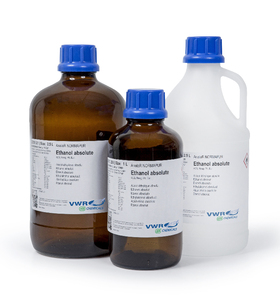VWR Benedict's reagent for qualitative detection of sugar in urine, 1L
Catalog No :
CAS Number :
Brand :
In Stock
Specifications:
| Application | Colorimetric Assay | ||
| Storage Temperature | Ambient | ||
| Product Type | Laboratory Chemical | Forms | Liquid |
| Product Brand | VWR | ||
| Product Grade | Analytical grade | ||
Qualitative Reagent for Reducing Sugar Detection in Biological Fluids
VWR Benedict’s Reagent is a classic, qualitative chemical reagent used for the detection and semi-quantitative estimation of reducing sugars, particularly glucose in urine. It is composed of copper(II) sulfate, sodium carbonate (alkaline), and sodium citrate, forming a stable blue solution that, when heated with a reducing sugar, produces a colored precipitate ranging from green to brick-red, depending on the sugar concentration.
The reagent reacts with reducing sugars by reducing cupric (Cu²⁺) ions to cuprous (Cu⁺) oxide, resulting in the characteristic precipitate. Benedict’s reagent is commonly used in clinical, biochemical, and educational laboratories for screening glucose and other reducing substances in urine and aqueous solutions.
Key Features & Benefits
✅ Ready-to-Use 1 L Solution – Convenient volume for multiple assays or routine screenings
✅ Stable Formulation – Long shelf life and reproducible results under proper storage
✅ Detects Reducing Sugars – Reacts with glucose, lactose, fructose, galactose, and others
✅ Color Change Indicates Sugar Concentration – Blue to green/yellow/orange/red precipitate
✅ Widely Used in Clinical Chemistry & Research – Suitable for qualitative glucose screening in urine and other aqueous samples
Applications
- Qualitative Detection of Glucose in Urine – Commonly used in diabetic screening
- Detection of Reducing Sugars in Research Samples – Including TLC analysis and plant metabolite studies
- Educational Demonstrations – Visual sugar detection experiments in biochemistry and physiology courses
- Synthesis of Cuprous Oxide (Cu₂O) – Used in materials science for SEM imaging and nanoparticle formation
- TLC-Based Sugar Detection – Paired with chromatography for metabolite visualization
Technical Specifications
| Attribute | Specification |
|---|---|
| Quantity | 1 Liter |
| Form | Aqueous solution |
| Composition | Copper(II) sulfate, sodium carbonate, sodium citrate |
| Detection Method | Colorimetric (visual color change upon heating) |
| Detection Target | Reducing sugars (e.g., glucose, lactose, fructose) |
| Detection Limit | 0.01% glucose in water (approx.) |
| Storage Conditions | Store at room temperature in tightly sealed container |
| Safety Classification | General lab reagent – handle with standard PPE |
| Shelf Life | Stable under normal storage conditions |
| Regulatory Use | For Research and Laboratory Use Only |
Usage Instructions
- Add Benedict’s reagent to the sample in a test tube (usually 5 mL reagent + 0.5–1 mL sample).
- Boil the mixture gently for 2–5 minutes.
-
Observe the color change:
- Blue = no reducing sugar
- Green to Yellow = trace to moderate sugar
- Orange to Brick Red = high reducing sugar concentration
Note: For reliable results, use fresh urine or prepared aqueous solutions of sugars.
VWR Benedict’s Reagent (1 L) is a trusted, easy-to-use solution for qualitative screening of reducing sugars, especially glucose in urine. Its visually distinct colorimetric response, chemical stability, and versatility across clinical and research applications make it an essential reagent for any biochemistry, diagnostic, or educational laboratory involved in carbohydrate analysis or urine testing.




 0
0
